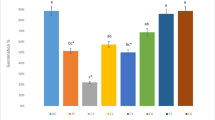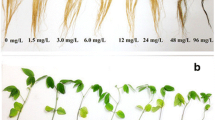Abstract
The effects of the endocrine disruptor bisphenol A (BPA) at concentrations of 10 and 50 mg l−1 were evaluated on the germination and morphology, micronuclei (MN) content in root tip cells and BPA bioaccumulation of hydroponic seedlings of broad bean (Vicia faba L.), tomato (Lycopersicon esculentum Mill.), durum wheat (Triticum durum Desf.) and lettuce (Lactuca sativa L.) after 6 and 21 days of growth. In general, BPA at any dose used did not inhibit germination and early growth (6 days) of seedlings of the species examined, with the exception of primary root length of tomato which decreased at the higher BPA dose. In contrast, an evident phytotoxicity was induced by BPA in all species after 21 days of growth with evident morphological anomalies and significant reductions of the lengths and fresh and dry weights of shoots and roots of seedlings. With respect to the nutrient medium without seedlings, BPA concentration decreased markedly during the growth period in the presence of broad bean and tomato seedlings, and limitedly in the presence of durum wheat and, especially, lettuce. Further, the presence of BPA measured in roots and shoots of broad bean and tomato after 21-day growth indicated that bioaccumulation of BPA had occurred. The number of MN in broad bean and durum wheat root tip cells increased markedly by treatment with BPA at both concentrations, thus suggesting a potential clastogenic activity of BPA in these species.



Similar content being viewed by others
References
Atkinson A, Roy D (1995a) In vivo DNA adduct formation by bisphenol A. Environ Mol Mutagen 26:60–66
Atkinson A, Roy D (1995b) In vitro conversion of environmental estrogenic chemical bisphenol A to DNA binding metabolite(s). Biochem Bioph Res Co 210:424–433
Cousins IT, Staples CA, Klečka GM, Mackay D (2002) A multimedia assessment of the environmental fate of bisphenol A. Hum Ecol Risk Assess 8:1107–1135
EDSTAC. (1998) Endocrine disruptors screening and testing advisory committee Final report. Available on line http://www.epa.gov/opptintr/opptendo/whatsnew.htm
Ferrara G, Loffredo E, Senesi N (2001) Aquatic humic substances inhibit clastogenic events in germinating seeds of herbaceous plants. J Agr Food Chem 49:1652–1657
Fürhacker M, Scharf S, Weber H (2000) Bisphenol A: emissions from point sources. Chemosphere 41:751–756
Hamada H, Tomi R, Asada Y, Furuya T (2002) Phytoremediation of bisphenol A by cultured suspension cells of Eucalyptus perriniana-regioselective hydroxylation and glycosylation. Tetrahedron Lett 43:4087–4089
Hewitt S, Hillman JR, Knights BA (1980) Steroidal oestrogens and plant growth and development. New Phytol 85:329–350
Jones JL, Roddick JG (1988) Steroidal estrogens and androgens in relation to reproductive development in higher plants. J Plant Physiol 133:510–518
Jung V, Olsson E, Caspersen S, Asp H, Jensén P, Alsanius BW (2004) Response of young hydroponically grown tomato plants to phenolic acids. Sci Hortic-Amsterdam 100:23–37
Kolpin DW, Furlong ET, Meyer MT, Thurman EM, Zaugg SD, Barber LB, Buxton HT (2002) Pharmaceuticals, hormones, and other organic wastewater contaminants in U.S. streams, 1999–2000: a national reconnaissance. Environ Sci Technol 36:1202–1211
Kulling SE, Metzler M (1997) Induction of micronuclei, DNA strand breaks and HPRT mutations in cultured Chinese hamster V79 cells by the phytoestrogen coumoestrol. Food Chem Toxicol 35:605–613
Nakagawa Y, Tayama S (2000) Metabolism and cytotoxicity of bisphenol A and other bisphenols in isolated rat hepatocytes. Arch Toxicol 74:99–105
Nakajima N, Oshima Y, Serizawa S, Kouda T, Edmonds JS, Shiraishi F, Aono M, Kubo A, Tamaoki M, Saji H, Morita M (2002) Processing of bisphenol A by plant tissues: glucosylation by cultured BY-2 cells and glucosylation/translocation by plants of Nicotiana tabacum. Plant Cell Physiol 43:1036–1042
Nakajima N, Oshima Y, Edmonds JS, Morita M (2004) Glycosylation of bisphenol A by tobacco BY-2 cells. Phytochemistry 65:1383–1387
Nitch JP (1967) Encyclopedia de la Pleiade. Le Phytotrons
Pfeiffer E, Rosemberg B, Deuschel S, Metzler M (1997) Interference with microtubules and induction of micronuclei in vitro by various bisphenols. Mutat Res 390:21–31
Pridham JB (1964) The phenol glycosylation reaction in the plant kingdom. Phytochemistry 3:493–497
Purdom CE, Hardiman PA, Bye VJ, Eno NC, Tyler CR, Sumpter JP (1994) Estrogenic effects of effluents from sewage sludge treatment works. Chem Ecol 8:275–285
Robbins RS, Bean SR (2004) Development of a quantitative high-performance liquid chromatography-photodiode array detection measurement system for phenolic acids. J Chromatogr A 1038:97–105
Safe S (2000) Bisphenol A and related endocrine disruptors. Toxicol Sci 56:251–252
Schmidt B, Schuphan I (2002) Metabolism of the environmental estrogen bisphenol A by plant cell suspension cultures. Chemosphere 49:51–59
Senesi N, Loffredo E, Padovano G (1990) Effects of humic acid-herbicide interactions on the growth of Pisum sativum in nutrient solution. Plant Soil 127:41–47
Shore LS, Kapulnik Y, Ben-Dor B, Fridman Y, Wininger S, Shemesh M (1992) Effects of estrone and 17β-estradiol on vegetative growth of Medicago sativa. Physiol Plantarum 84:217–222
Staples CA, Dorn PB, Klecka GM, O’Block ST, Harris LR (1998) A review of the environmental fate, effects, and exposures of bisphenol A. Chemosphere 36:2149–2173
Suzuki T, Nakagawa Y, Takano I, Yaguchi K, Yasuda K (2004) Environmental fate of bisphenol A and its biological metabolites in river water and their xeno-estrogenic activity. Environ Sci Technol 38:2389–2396
Takahashi S, Chi XJ, Yamaguchi Y, Suzuki H, Sugaya S, Kita K, Hiroshima K, Yamamori H, Ichinose M, Suzuki N (2001) Mutagenicity of bisphenol A and its suppression by interferon-α in human RSa cells. Mutat Res 490:199–207
Vaughan D, Malcolm RE (1985) Influence of humic substances on growth and physiological processes. In: Vaughan D, Malcolm RE (eds) Soil organic matter and biological activity. Nijhoff-Junk, Dordrecht, The Netherlands, pp 37–75
Vaughan D, Ord B (1990) Influence of phenolic acids on morphological changes in roots of Pisum sativum. J Sci Food Agric 52:289–299
Williams RT (1967) The biogenesis of conjugation and detoxification products. In: Bernfeld P (ed) Biogenesis of natural compounds. Pergamon, Oxford, pp 589–639
Yamamoto T, Yasuhara A, Shiraishi H, Nakasugi O (2001) Bisphenol A in hazardous waste landfill leachates. Chemosphere 42:415–418
Author information
Authors and Affiliations
Corresponding author
Rights and permissions
About this article
Cite this article
Ferrara, G., Loffredo, E. & Senesi, N. Phytotoxic, clastogenic and bioaccumulation effects of the environmental endocrine disruptor bisphenol A in various crops grown hydroponically. Planta 223, 910–916 (2006). https://doi.org/10.1007/s00425-005-0147-2
Received:
Accepted:
Published:
Issue Date:
DOI: https://doi.org/10.1007/s00425-005-0147-2




